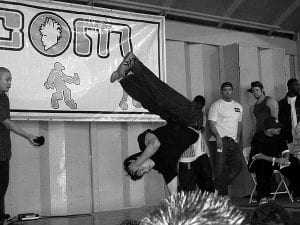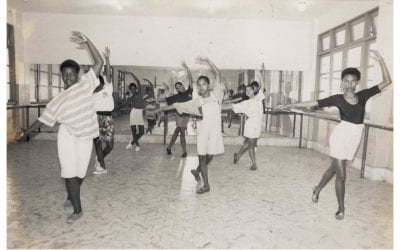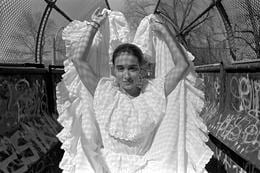Brazilian Breakdancing

Photo by fictures / CC by 2.0
When you think about breakdancing, images of kids popping, locking, and wind-milling, hand– standing, shoulder-rolling, and hand-jumping, might come to mind. And those kids might be city kids dancing in vacant lots and playgrounds. Now, New England kids of all classes and cultures are getting a chance to practice break-dancing in their school gyms and then go learn about it in a teaching unit designed by Veronica Boix-Mansilla, Jodi Falk and Alison Rhodes at Harvard’s Project Zero.
The unit, which is part of Boix Mansilla and Howard Gardner’s interdisciplinary studies project, places hip hop youth culture in the broader context of globalization today. It seeks to help students draw on elements of anthropology and dance to understand that youths the world over are performing breakdancing for all sorts of reasons. So while in one sense hip hop as a form of youth culture has become global, in another sense it takes deeply rooted local meanings. The dance, one of many aesthetic expressions of hip hop culture, migrated long ago from its popularly recognized 1970s origins in the Bronx. By the 1980s, it had spread all over the United States, from the roughest neighborhoods to the manicured lawns of suburbia, and then to the streets of Bangkok, Seoul, and Tokyo. And to the Brazilian favelas of São Paulo, Rio, and Salvador as well.
When Boix-Mansilla received funding from Atlantic Philanthropies to collaborate with 12 Massachusetts teachers in the design of a pedagogical framework for quality interdisciplinary teaching, she wanted her team to tackle the question of how to teach about globalization –a contemporary force shaping students lives on the planet and one that will define the work of their generation. One of the experimental units was developed in collaboration with Jodi Falk, director of dance at Pioneer Valley Performing Arts Center in western Massachusetts. To gather materials for her work she visited hip hop hipsters in Salvador de Bahia and Sao Paulo. With the help of Joao Kulcsar, Falk documented the Brazilian breakdancing in videotapes and interviews and applied the principles of Laban Movement Analysis for instructional purposes. Synthesizing Falk’s observations and Boix-Mansilla’s background research, Alison Rhodes in turn published an article in the Journal of Dance Education (Vol. 6, No. 2, 2006). “We investigated how hip hop as a form of dance had been interpreted in Brazil,” she says, “as part of a more broadly shared youth culture.”
Breakdancing, anthropologists have found, is not simply a matter of what Boix-Mansilla calls “copying a globalized product.” In the United States, poor black and Latino youth learned to express personal agility within confined public spaces—not to mention the opportunity to show off some bling. In Japan, middle-class kids used breakdance to express freedom from a circumscribed culture. In Brazil, meanwhile, it has offered young people in the favelas a chance to celebrate their Afro-Caribbean roots in defiance of racial oppression. “There’s a commitment to political participation—to the fight against poverty and for human rights among Brazilian youth,” stresses Boix-Mansilla. And it hasn’t necessarily meant importing a foreign dance in favor of a traditional one.
Dance anthropologist Pearl Primus has noted that the origins of acrobatic breakdancing are not North American, but Central and West African. From the bushasche dance of the Bantu people in the Congo and the fanga of the Liberians emerged capoeira, a martial art created by enslaved Africans in Brazil and practiced in the state of Bahia. That is where Brazilians assume they got the form—from the same African places, perhaps, as the “boyz in the hoodz” of the Bronx. And if they’re breakdancing in the streets thanks in part to a 1970s New York dance craze, they do so with little sense of indebtedness. It’s their very own.
As many New England schoolchildren will soon be able to tell you.
Scott Ruescher is the program coordinator of the Arts in Education Program at the Harvard Graduate School of Education and an English instructor in the Boston University Prison Education Program.
Related Articles
Editor’s Letter: Dance!
We were little black cats with white whiskers and long tails. One musical number from my one and only dance performance—in the fifth grade—has always stuck in my head. It was called “Hernando’s Hideaway,” a rhythm I was told was a tango from a faraway place called Argentina.
Dance Revolution: Creating Global Citizens in the Favelas of Rio
Yolanda Demétrio stares out the window of our public bus in Rio de Janeiro, on our way to visit her dance colleagues at Rio’s avant-garde cultural center, Fundição Progresso. Yolanda is a 37-year-old dance teacher, homeowner, social entrepreneur and former favela (Brazilian urban shantytown) resident. She is the founder and director of Espaço Aberto (Open Space), an organization through which Yolanda has nearly …
Disruption in the Immigrant Experience: Colombian Youth Dance Their Way to Continuity
Imagine you are fifteen years old. As an immigrant who has lived in the United States for a few years, you are still trying to find your place. You decide to join a group that dances the traditional dances of your country. You practice every week on Fridays, when you could be going to the movies or hanging out with your friends. Your goal is to perform in that big annual show a lot of people have told you about. That day has finally …




